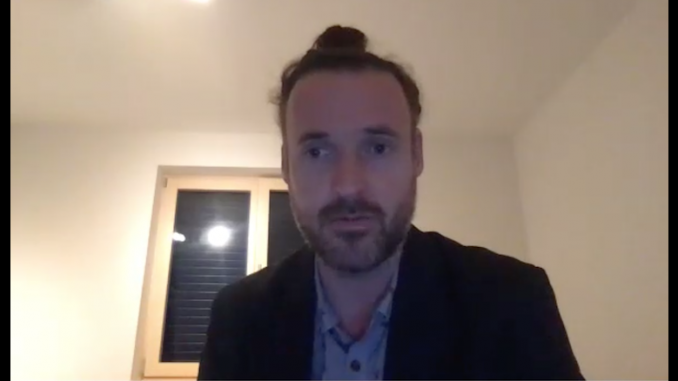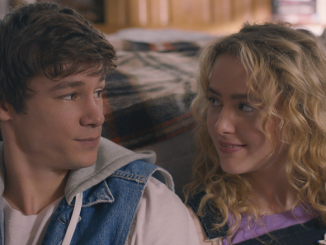
Schrödinger’s Cat, Magic Eye 3D, Painful Roller Skates, Mental Health, Addiction, and the Syntax of Film.
While I only spoke with Mike Cahill for 15 minutes, it feels like we covered a multitude of topics. There’s no denying the passion within this man who wrote and directed Boxers and Ballerinas, Another Earth, I Origins, and, most recently, Bliss. I have a feeling that many would listen to Mike speak and confuse his passion for pretension, but I heard him speak with the same passion about Soderbergh, Schnabel, and Kieślowski as he did about Magic Eye 3D posters from the 90s. His love of film was crystal clear. I feel like I could have been sharing a beer at a bar with a friend and had a very similar conversation.
Mike was on a Zoom press tour talking about Bliss, his latest film, which is available worldwide on Prime Video. Since I started writing reviews, I’ve come across numerous films that I would have otherwise never watched; films that I’ve come to love and recommend on a regular basis. Bliss is now one of those films. I’ve recommended it to friends, family, and colleagues; essentially anyone that will listen to me. This movie, much like a few other favourites – Archive, Last Call, One Good Reason, and Triggered – seems to get nothing but agreement that it is a great film. Check out my review and watch the film, then come back and read the rest of this review because – SPOILER ALERT – this will discuss the film in detail.
So, while the full review is available… let’s quickly summarize the film. Owen Wilson plays Greg, a struggling divorced father who loses his job and, in the process, appears to kill his boss. This puts him into a spiral and, to calm his nerves, he heads to a bar across the street, where he meets Isabel (Salma Hayek). Isabel tells Greg that they are in a simulation and nothing matters. Ultimately, she shows Greg a better world, the “Bliss world”, which is a stark contrast to the “ugly world”, which looks more akin to our world… the real world. The movie does not provide any evidence as to which world is real. Is it the Bliss world, the ugly world, or both? There’s no definite answer, so I asked Cahill for his thoughts. Initially, he said that he couldn’t answer that question, he couldn’t give his opinion on which was real, but he added this thought.
It is a real place. Basically, I wanted to tell a story that treated the fragility of the mind with empathy. We all see the world subjectively, but that subjectivity can be even more enhanced with issues of mental health, the chemical make up of your mind, and the emotional landscape of your mind. So, the way you see the world can be drastically shifted based off of those inputs and it can almost feel or appear like a different world. Yes, the Bliss world is a real world. It produces inputs and creates feelings and you can interact with it, but I’d also a hallucination is real too.
Mike Cahill, writer/director
These are profound and thought-provoking words on their own, but as Mike and I continued to chat his insights would prove to be ever more astounding. One of the aspects of the film that I truly loved was the use of the background of the scenes and the settings to really convey what was happening and, speaking to Mike, I realize just how much thought was put into these elements. In fact, I brought up one of those scenes that stood out to me because it appeared to break away from other occurrences. As you’re watching the film, there are plenty of moments that make you wonder what is going on. You ask what is broken and wonder if it is a simulation. The one that stood out to me was a moment early on in the film, when Greg leaves the room, but his wallet glitches like a broken hologram. Since most of the other glitches occur when Greg is in frame, I asked Mike about this.
Every single one of these details has been mulled over and thought through. I try to maintain first person subjective narrative, like our protagonists point of view but emotionally charged. So, the things that he is feeling throughout the film are projected around the world. I try to transform feelings – using the visual language of cinema to turn feelings into things, objects, places, glitches, or shifts. Even though his eyes aren’t there watching the wallet glitch, we need to experience that to align the viewer with him. Even right before that, for example, he crushes these pills and the camera walks away and looks out the window. It’s a strange choice. Why would you walk away from that happening? It’s like we’re not paying attention to what he’s even doing… it’s almost like this behaviour choice that he’s falling into is something he doesn’t even want to look at.
It produces strange syntactical results like outside the roller disco. To feel what he’s feeling – they run out, they stole these clothes, and they see the police cars drive away – we exploit film syntax. When you look at something it’s the next shot in the sentence of the visual language, but to see oneself and then to shift POV to suddenly be in the back of a police car is incredibly disorienting. It makes you have to reassess the entire scene that happened before, which is the loss of our moral compass in relationship to this world. What that does is that it disorients us in the same way that it disorients him. Usually, with movies that talk about mental health and addiction, you kind of lose your character at some point. You become separated from them because you have to observe what’s “really” happening to them. What I wanted to do was to never see what’s “really” happening to them but always feel what’s REALLY happening in their internal landscape. This makes for a strange film that’s very hard to click into, but if you click into it, if you get on the rails and start riding with it, you can feel that it’s carried through from frame one to the final frame.
Mike Cahill, writer/director
Mike and I spoke before the film’s release, but I wanted to wait until people had seen the film before sharing this interview and part of my reasoning for that was his answer to my next question. We’re only a couple of years apart in age, so we experienced many cultural aspects through a similar lens. This was a short chat, but I have a feeling that I could spend hours discussing film with him. I was really impressed with how insightful he was, which is why I wanted to know if he planned on any public discussions around the film. When I asked if he had any plans to live tweet the premiere or do a Q&A, I was both impressed and surprised when he answered my question using Magic Eye 3D as a point of reference.
I think of Magic Eye 3D quite a lot, maybe because my teen years were in the 90s. Something about Magic Eye is interesting, right? It’s this weird collage of colours. Some people can stare at it and, if they click into it, suddenly it becomes this 3D image, but there’s certain people that can’t click into it or they need patience to click into it. I feel like there’s certain people that somehow just walk up to magic eye and see the iceberg and penguin. And not only do they see the image, they also feel what we’re chasing. The movie is atypical in the sense that it’s not a science fiction thriller or this mind bending thing, even though it’s sold as one. Really, it’s an experiment with a movie to try and use cinema to show the fragility of the mind and the different ways of seeing things. I don’t want to infuse too much of my “blah blah blah” into people’s experience. I feel like the movie serves as a framework for people to project their way of seeing onto it. I think I might lessen the impact if I talk too much about it.
Mike Cahill, writer/director
I think it is important to say that we shared a very 90’s moment after Mike mentioned Magic Eye 3D, where I suggested his mention of it might make him a fan of Mallrats to which he replied, “It’s a sailboat.”
Following along with my standard line of questioning, I asked if he was influenced by anything or drew from any experiences when writing this film. He referenced Steven Soderbergh’s Sex, Lies, and Videotape and the way the final scene creates a “biased ability of interpretations” because there are two possible answers for what happens, but neither of them are given. He compared it to the Mona Lisa and the question of whether she is smiling or frowning. He also spoke of Schnabel’s Basquiat and Kieślowski’s Red.
All too often we humans want answers to things. You know how there’s gas, liquid, and solid? Solids are the only state of an element that we can put somewhere, we can put it on our desk or in the trash; we can contain it. I feel like there’s a certain type of work that can’t be circumscribed, that can’t be contained. I learned that through Soderbergh’s work, through Kieślowski’s Red, and through Schnabel’s Basquiat. I learned that through all these wonderful films that I saw in my 20s. I wanted to try my hand at that. I wanted to make something ambitious in terms of cinematic possibilities; whether this film could give plausibility to both words – the Bliss world and the ugly world. Like in some ways you could walk away from the film and say this one is the valid reality, no this one is, and go back and forth, before you come to the conclusion yourself that maybe which one is real, maybe our seeking of answers, is a mistake.
Maybe we should try and get comfortable with the complexity of a duality. That Schrödinger’s cat is dead or alive at the same time. Maybe we should try and get ourselves comfortable with that and see what the real choice is. The real choice is not knowing the answer – the real choice is knowing that you have power over where you invest your time, where you put your heart, what you choose. That’s why he says, “This woman says she’s my daughter and I believe her.” That’s a statement of agency; that’s heroic; for him and his point of view, that statement alone is his Mount Everest. Not works that are ambiguous, because that means many options, but two pillars or three pillars – a tripod of stability in the interpretation. This was my attempt at doing that by telling a story about mental health, addiction, the idea of seeing a different world, and the beauty of someone who loves you – who reaches across those worlds and tries to give you a hand and pull you back.
Mike Cahill, writer/director
As I said at the beginning, Mike’s words were profound and that sentiment, that idea, that someone would reach out across the void, bridging the gap between worlds to pull you back to reality is quite beautiful. I loved this film so much that I asked about a sequel. While Cahill joked that they said a sequel would be called Blister due to how painful the roller skates were, he mentioned that this was a contained piece.
I wanted to get to this conclusion where he says, “I’m sorry I’m late” and she says, “You’re not late, you’re here”. For me, the finality of that feels right.
Mike Cahill, writer/director
And the finality of that quote feels right to me. Thank you to Mike for taking the time to speak and thank you for sticking around to the end. If you have not seen Bliss, you may know more than you want to, but you should still check the film out because it is phenomenal.



